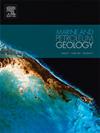Machine learning-based sweet spot prediction for lacuscrine shale oil in the Weixinan Sag, Beibu Gulf Basin, China
IF 3.6
2区 地球科学
Q1 GEOSCIENCES, MULTIDISCIPLINARY
引用次数: 0
Abstract
This study aims to overcome challenges related to sparse well distribution, pronounced lithological heterogeneity, and limited core data in offshore lacustrine shale oil reservoirs through the development of an integrated evaluation framework that enables quantitative prediction and spatial mapping of sweet spots. Conventional well logs, nuclear magnetic resonance (NMR) data, geochemical analyses, and laboratory measurements are integrated to construct a grading system for four key properties—reservoir quality, oil-bearing property, mobility, and fracability—with threshold values determined by statistical distributions. To address sample scarcity, a Generative Adversarial Network (GAN) is applied for data augmentation, while Recursive Feature Elimination with Cross-Validation (RFECV) is employed for optimal feature selection. Considering the complex, nonlinear, and anisotropic nature of shale reservoirs, a Generalized Regression Neural Network (GRNN) is constructed, with its smoothing parameter globally optimized using the Sparrow Search Algorithm (SSA), resulting in high predictive accuracy (R2 > 0.8). Furthermore, the study establishes a coupling relationship between lithofacies assemblages and the four properties. This integrated approach supports spatial prediction of both individual parameters and the comprehensive sweet spot evaluation index. The results indicate that laminated (LSA) and interbedded (ISA) shales exhibit distinct sweet spot characteristics (porosity >6 %, clay content <25 %, and OSI >100) with high-potential zones primarily located in the central W1, southeastern W2, and central W3 regions. This methodology offers a reliable technical framework for quantitative assessment and development planning of offshore lacustrine shale oil resources under data-constrained conditions.
基于机器学习的北部湾盆地涠西南凹陷湖相页岩油甜点预测
本研究旨在通过开发一种综合评价框架,实现定量预测和甜点空间映射,克服近海湖相页岩油藏井分布稀疏、岩性非均质性明显和岩心数据有限等挑战。常规测井、核磁共振(NMR)数据、地球化学分析和实验室测量相结合,构建了一个四项关键属性(储层质量、含油量、流动性和可压裂性)的分级系统,阈值由统计分布确定。为了解决样本稀缺性问题,采用生成对抗网络(GAN)进行数据增强,采用递归特征消除交叉验证(RFECV)进行最优特征选择。考虑到页岩储层的复杂性、非线性和各向异性,构建了广义回归神经网络(GRNN),并采用麻雀搜索算法(SSA)对其平滑参数进行全局优化,得到了较高的预测精度(R2 >;0.8)。建立了岩相组合与四种物性之间的耦合关系。该综合方法既支持单项参数的空间预测,也支持综合甜点评价指标的空间预测。结果表明,层状(LSA)和互层状(ISA)页岩具有明显的甜点特征(孔隙度>; 6%,粘土含量<; 25%, OSI >100),高电位区主要位于W1中部、W2东南部和W3中部地区。该方法为数据受限条件下近海湖相页岩油资源的定量评价和开发规划提供了可靠的技术框架。
本文章由计算机程序翻译,如有差异,请以英文原文为准。
求助全文
约1分钟内获得全文
求助全文
来源期刊

Marine and Petroleum Geology
地学-地球科学综合
CiteScore
8.80
自引率
14.30%
发文量
475
审稿时长
63 days
期刊介绍:
Marine and Petroleum Geology is the pre-eminent international forum for the exchange of multidisciplinary concepts, interpretations and techniques for all concerned with marine and petroleum geology in industry, government and academia. Rapid bimonthly publication allows early communications of papers or short communications to the geoscience community.
Marine and Petroleum Geology is essential reading for geologists, geophysicists and explorationists in industry, government and academia working in the following areas: marine geology; basin analysis and evaluation; organic geochemistry; reserve/resource estimation; seismic stratigraphy; thermal models of basic evolution; sedimentary geology; continental margins; geophysical interpretation; structural geology/tectonics; formation evaluation techniques; well logging.
 求助内容:
求助内容: 应助结果提醒方式:
应助结果提醒方式:


